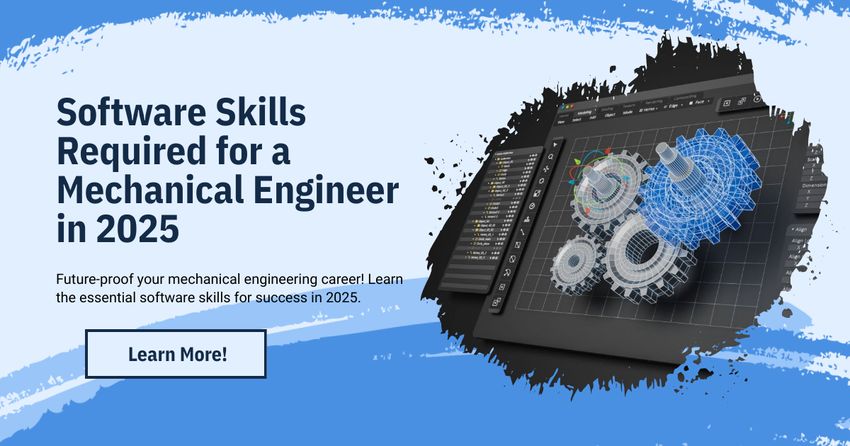In the ever-evolving field of mechanical engineering, staying up-to-date with modern technologies and software is crucial for career growth and effectiveness. As we step into 2025, the demand for mechanical engineers who can integrate traditional engineering knowledge with cutting-edge software tools has grown significantly. From design and simulation to automation and data analysis, software proficiency is no longer optional – it’s essential. 🌍💡
Let’s dive into the most important software skills every mechanical engineer should possess in 2025 to remain competitive and innovative. 🧠👨💻
1️⃣ Computer-Aided Design (CAD) Software 🖊️📐
CAD tools remain the bedrock of mechanical design and product development. Engineers use them for creating precise 2D and 3D models of components, assemblies, and systems.
Key Tools to Learn:
-
SolidWorks – Known for ease of use and parametric modeling.
-
AutoCAD – Still widely used for 2D designs and layouts.
-
CATIA – Popular in aerospace and automotive industries.
-
PTC Creo – Excellent for complex product design.
-
Fusion 360 – Combines CAD, CAM, and CAE in one platform.
Why It’s Important:
CAD proficiency ensures fast, accurate prototyping and helps reduce design errors. Engineers with CAD skills can collaborate more effectively with manufacturing and interdisciplinary teams. 🧱🖥️
2️⃣ Finite Element Analysis (FEA) & Simulation Software 🔍🧪
Simulating how products behave under stress, heat, or vibration is crucial before physical testing.
Must-Know Tools:
-
ANSYS – Powerful for structural, thermal, and fluid simulations.
-
Abaqus – Preferred in automotive and defense industries.
-
COMSOL Multiphysics – Good for multiphysics problems.
-
SimScale – Cloud-based FEA and CFD simulation tool.
Why It’s Important:
Simulation tools save time and money by reducing the need for physical prototypes and optimizing designs early in the process. Engineers skilled in FEA can predict failure points and improve reliability. 🧱⚡
3️⃣ Computer-Aided Manufacturing (CAM) Software 🧰🏭
CAM software bridges the gap between design and production by helping engineers plan and control manufacturing processes.
Popular CAM Software:
-
Mastercam
-
Fusion 360 (CAM module)
-
NX CAM
Why It’s Important:
Knowing CAM enables mechanical engineers to streamline manufacturing, enhance precision, and improve cost efficiency. Integration of CAD and CAM ensures a smoother workflow from concept to production. ⚙️💡
4️⃣ Programming and Scripting Languages 👨💻🧠
Mechanical engineers who can write code have a significant edge. Programming helps automate tasks, analyze data, and even integrate machine learning into engineering solutions.
Recommended Languages:
-
Python – Easy to learn and powerful for data analysis and simulation.
-
MATLAB – Used extensively for mathematical modeling and control systems.
-
C/C++ – Useful in embedded systems and high-performance computing.
-
VBA/Excel Macros – Automate repetitive tasks in Excel.
Why It’s Important:
Coding lets engineers build custom tools, automate simulations, and work more efficiently with data. It also opens doors to emerging fields like AI in engineering. 🤖📊
5️⃣ Data Analysis and Visualization Tools 📊📉
As Industry 4.0 progresses, engineers are expected to work with large datasets from sensors, simulations, and experiments.
Essential Tools:
-
Excel with advanced functions
-
MATLAB – For signal processing and matrix operations.
-
Tableau/Power BI – For dashboard creation and decision-making.
-
Python with Pandas & Matplotlib – For data wrangling and plotting.
Why It’s Important:
The ability to analyze data helps engineers validate hypotheses, monitor product performance, and present clear insights to stakeholders. 📈💬
6️⃣ Product Lifecycle Management (PLM) Systems 🔄🗂️
PLM tools help manage the entire lifecycle of a product – from ideation through manufacturing to end-of-life.
Popular PLM Software:
-
Siemens Teamcenter
-
PTC Windchill
-
Autodesk Vault
Why It’s Important:
PLM software ensures better collaboration, traceability, and compliance with industry standards. Understanding PLM is key in large-scale product development. 🔧🔍
7️⃣ Automation & Robotics Software 🤖⚙️
As automation becomes central to manufacturing, mechanical engineers must be familiar with robotics programming and control systems.
Tools to Know:
-
Robot Operating System (ROS)
-
LabVIEW
-
Siemens TIA Portal (PLC programming)
Why It’s Important:
Engineers who can design and program robotic systems are in high demand. This skill is crucial for smart factories, process optimization, and industrial automation. 🏭💻
8️⃣ AI & Machine Learning Integration 🧠🔗
Mechanical engineering is embracing AI to enhance design optimization, predictive maintenance, and quality control.
Helpful Tools & Libraries:
-
TensorFlow/Keras
-
Scikit-learn
-
Python (NumPy, Pandas)
Why It’s Important:
AI enables faster problem-solving and smart decision-making. Engineers equipped with these skills will shape the future of intelligent product design. 🧬📡
🌐 Bonus: Cloud Platforms & Collaboration Tools ☁️🤝
In 2025, remote collaboration and cloud-based workflows are the norm.
Must-Have Knowledge:
-
Git/GitHub – For version control.
-
Microsoft Teams/Slack – For team communication.
-
Cloud CAD tools like Onshape.
-
Google Workspace/SharePoint – For document collaboration.
Why It’s Important:
Digital collaboration tools are vital for cross-functional teamwork and efficient project management. 🎯🗃️
🔚 Conclusion: Future-Proofing Your Engineering Career 🎓🚀
The mechanical engineer of 2025 is more than just a technical designer – they are a digitally empowered problem solver. Mastering these software tools not only improves job performance but also ensures adaptability in a rapidly evolving industry. The synergy of traditional engineering principles with software expertise is the winning formula for future-ready engineers. 🔩💼
By staying current with these skills, mechanical engineers can lead innovation in fields ranging from renewable energy to robotics and aerospace. 💫🌐


